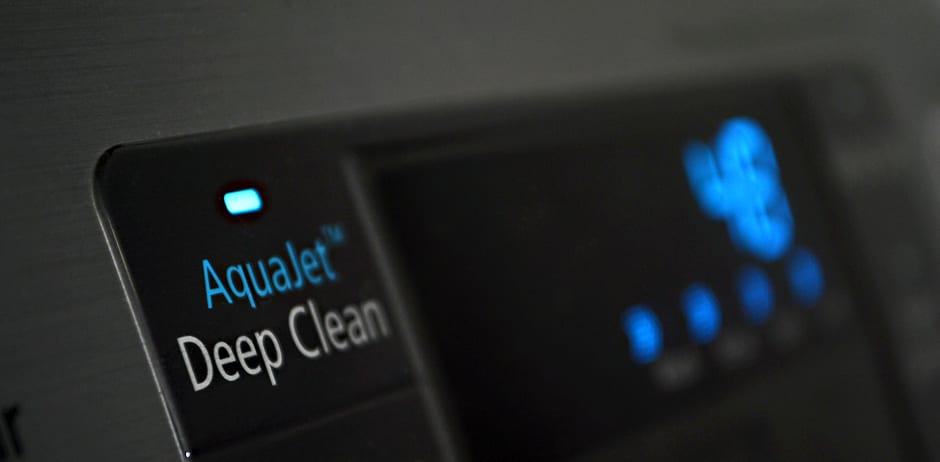Introduction
Certain serial numbers of this model may be affected by this issue. As such, we have chosen to rescind our Editors’ Choice award for this product until we have more information on Samsung’s plans to remedy the situation.
And in this corner, weighing in at 142 pounds and 5 cubic feet of capacity, the Samsung WA50F9A8DSP (MSRP $1,199.99). I'm telling you, this Samsung is tough. And its capacity means it'll knock down more stains than the competition. Top-loaders may be old, but this washer has learned new tricks, including a dozen cycles and plenty of features. Stains are going to have a rough time here at the Laundry Lab tonight. Let's take it down to Jon Chan in Design and Usability.
Design & Usability
Large, but not overwhelming
Thanks, Jon. It's getting awkward down here tonight as I write about myself in the third person. At 29 inches deep, this washer takes up a little more space than the traditional, 27-inch top-loader, but it will still fit into most laundry closets. The features buttons are designed for light tapping, but for some reason you will have to hit pretty hard when selecting temperatures, or else your punches won't register. Overall, this top-loader operates like any other: turn the knob, press the start button. In fact, aside from some fancy trim, the design is essentially the same as Samsung's other new top loader, the WA456DRHDSU. Also, it should be noted that you can take off $100 off the MSRP should you prefer a plain white machine (its model number is WA50F9A6DSW) over a stainless platinum one. Sale prices may bring your total cost below $800.
{{photo_gallery "gallery"}}
Performance & Features
Has Predictable Moves, No Haymakers Here
None of the cycles on Samsung's WA50F9A8DSP proved to be barn burners. The Heavy Duty cycle proved best, doing as well as other machines with lower capacities. The Normal cycle came in second place, but it fell a bit below average. It's hard to get even cleaning out of a huge washer drum, so we weren't surprised. Our standardized tests dictate that we use the same load in this machine as in smaller ones, so we don't know if filling it to the brim would improve performance.
Focusing on pure performance misses this machine's biggest draw: its sheer capacity. There are few contenders that can handle this much laundry, including GE's GTWS8650DWS. The GE beats the Samsung on features—it's got an automatic detergent dispenser, for example—but the Samsung edges out the GE on performance.
Conclusion
Samsung's WA50F9A8DSP really earns its moniker of Super King Sized. While the words "Super King" bring to mind thoughts of a flying Elvis, it aptly describes this washing machine. It's not the most effective machine on the market, but its massive capacity and sub-$800 sale price (if you buy one finished in white) makes it ideal for big families or anyone with lots of laundry to do.
Science Introduction
Every laundry set that steps into our testing ring gets quite a workout. Performance and Efficiency are our major concerns. So let's get ready to rumble.
Cleaning Performance
Cleaning performance is exactly what it sounds like. How much stain can each cycle lift? For stains, we use standardized strips which are coated in substances like blood, sweat, and cocoa. The WA50F9A8DSP managed to deal with sweat and cocoa on equal footing. That's a good sign since they're both on opposite sides of the pH scale. In fact, it was one of the better top-loaders we've tested. That still means its outclassed at stain removal by similarly-priced—albeit more cramped—front loaders.
{{photo_gallery "science 1"}}
Efficiency
Efficiency is two pronged approach for us. It's all about what goes in and what comes out. What goes in is water and electricity and what comes out is wet clothing.
First, we estimate that what goes into this washer will cost you around $59 each year. We found this out by hooking up the WA50F9A8DSP to water and watt meters, and applying the results to an equation that takes into account how many washes of each cycle an average consumer does in a year. That's about twice as pricey as some of the most efficient machines we've tested. However, you should keep in mind that you can do twice as much laundry with this machine.
{{photo_gallery "science 2"}}
What comes out is also important. The wetter a load of laundry is when coming out of the washer, the more work has to be done by a dryer. In this regard, this Samsung didn't do that well. Test loads retained about 64 percent of their weight in water. Anything above 50 percent is less than ideal.
Meet the tester
Jonathan Chan currently serves as the Lab Manager at Reviewed. If you clean with it, it's likely that Jon oversees its testing. Since joining the Reviewed in 2012, Jon has helped launch the company's efforts in reviewing laptops, vacuums, and outdoor gear. He thinks he's a pretty big deal. In the pursuit of data, he's plunged his hands into freezing cold water, consented to be literally dragged through the mud, and watched paint dry. Jon demands you have a nice day.
Checking our work.
Our team is here to help you buy the best stuff and love what you own. Our writers, editors, and experts obsess over the products we cover to make sure you're confident and satisfied. Have a different opinion about something we recommend? Email us and we'll compare notes.
Shoot us an email


